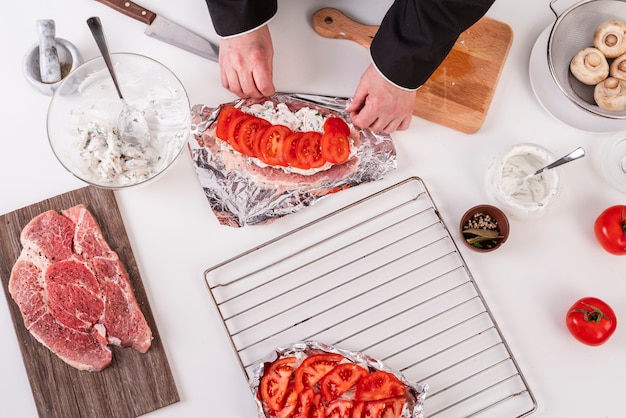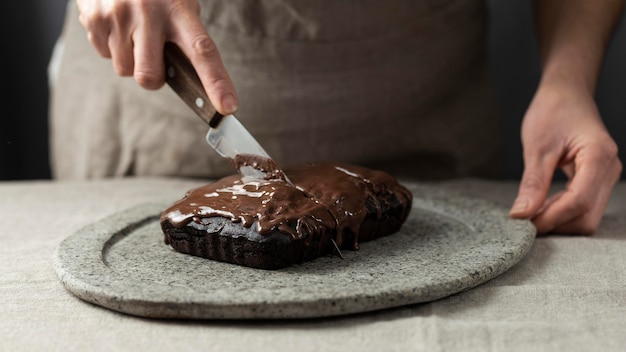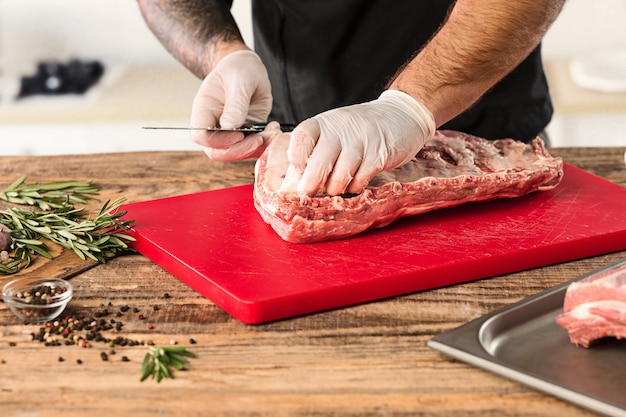Ah, the ribeye. It's a steak that practically sings with flavor, a cut that demands attention and respect. But let’s be honest, sometimes getting that perfect sear and juicy interior can feel like a gamble. You know, those moments when you're staring down a piece of raw meat and thinking, "Will I succeed, or will I end up with a dry, disappointing mess?" Well, fear not, my fellow steak enthusiasts! I've been there, done that, and learned a thing or two along the way. This guide is the result of countless hours spent in the kitchen, experimenting, tweaking, and yes, even making a few mistakes. But through it all, I've discovered the secrets to achieving steak perfection. So, grab a glass of your favorite red, find a comfy spot, and let's embark on a culinary journey to mastering the art of the ribeye.
(Part 1) choosing the right ribeye: The Foundation of a Great Steak

Let's start with the foundation of any great steak experience: selecting the right ribeye. It's like choosing the perfect ingredient for a delicious dish—you wouldn't use a stale loaf of bread for a decadent sandwich, would you? So, let's get picky!
The Importance of Marbling: The Key to Juicy Tenderness
Look, a ribeye is all about that beautiful marbling—the flecks of fat that run through the muscle. It's like the gold dust of the steak world, adding richness, juiciness, and incredible flavor. The fat renders out during cooking, creating a symphony of taste sensations. When you're choosing your ribeye, look for a steak with a good, even distribution of marbling, like a beautiful tapestry woven with threads of flavor. It should be present but not excessive. Too much fat can make the steak greasy, and you might find yourself swimming in a pool of rendered fat rather than savoring a succulent steak.
Thickness Matters: Finding the Sweet Spot
Next, consider the thickness. Aim for a ribeye that's about 1 to 1.5 inches thick. This provides the perfect balance: enough surface area for a fantastic sear and sufficient depth for a juicy, flavorful interior. Too thin, and you risk a dry, chewy steak; too thick, and you'll be staring at the clock, waiting for it to cook.
Quality and Freshness: Always a Priority
Don't forget to check the quality and freshness of your ribeye. It should have a vibrant red color, a smooth surface, and a fresh, inviting aroma. And, bonus points if there's a bit of extra fat around the edges—that's a sure sign of a good quality cut.
(Part 2) Prepping Your Ribeye for Steak Perfection: The Art of Preparation

Now that you've found your perfect ribeye, it's time to give it some TLC, to set the stage for an unforgettable steak experience.
Bringing it to Room Temperature: The Key to Even Cooking
Think of this step as giving your steak a spa treatment—a little pampering before the big event. Take your ribeye out of the fridge and let it sit at room temperature for at least 30 minutes. This is crucial for even cooking. A cold steak will cause the outside to cook too quickly before the inside has a chance to heat up properly, resulting in an unevenly cooked steak.
Patting it Dry: Achieving a Crisp, Flavorful Crust
Next, pat your ribeye dry with paper towels. This might seem like a small detail, but it's essential. Moisture on the surface of the steak will steam during cooking, preventing that crispy, flavorful crust you're aiming for. Think of it like removing the dampness to allow the heat to work its magic.
Seasoning with Care: Amplifying the Flavor
Now for the fun part—seasoning your steak! This is your chance to personalize your steak experience, to add your signature touch.
Salt and Pepper: The Classic Duo
I'm a big believer in the simple magic of salt and pepper. It's a timeless combination that lets the natural flavors of the steak shine through. Use kosher salt for its larger crystals, which season more evenly and dissolve more slowly, and freshly ground black pepper for its robust aroma and a touch of heat.
spices and herbs: A World of Flavor Possibilities
But don't be afraid to get creative! Experiment with your favorite spices and herbs. Garlic powder and onion powder are always good choices, adding a savory depth to the steak. A sprinkle of paprika or a pinch of cayenne pepper adds a bit of heat. For a more sophisticated touch, try a blend of herbs like thyme, rosemary, or oregano. Remember, there are no hard and fast rules. Use what you love and enjoy the process of flavor exploration.
The Secret to Perfect Seasoning: Less is More
Whether you opt for simplicity or a spice-filled symphony, remember to season generously. Don't be shy; embrace the boldness of flavor! And here's a little tip: press the seasoning into the fat around the edges of the steak, adding an extra layer of flavor to the finished product.
(Part 3) Getting Ready to Cook Your Ribeye: Setting the Stage for Success

Your ribeye is prepped and ready to go. Now it's time to prepare your cooking battlefield, the stage where your culinary masterpiece will be born.
Choosing the Right Pan: A Foundation for Success
For a truly outstanding ribeye, a cast iron skillet is your best friend. It heats up quickly and evenly, producing a beautiful sear, and its ability to retain heat helps ensure even cooking. If you don't have a cast iron skillet, a heavy-bottomed pan will do the trick. Just make sure it's a pan that can withstand high heat.
Oil Up: The Lubricant for a Beautiful Sear
Heat your chosen pan over medium-high heat. Add enough oil to coat the bottom of the pan. Choose an oil with a high smoke point, like canola or grapeseed oil, to prevent the oil from burning. Think of the oil as the lubricant that allows your steak to glide across the pan, achieving a beautiful, even sear.
Testing the Heat: Ensuring the Perfect Cooking Temperature
Now, it's time to make sure your pan is hot enough. I like to use a little trick for this. Drop a few drops of water into the hot pan. If they sizzle and evaporate quickly, your pan is ready. If the water sits there and doesn't sizzle, your pan needs more heat. You want the pan screaming hot for that perfect sear.
(Part 4) The Big Sear: Creating a Flavorful, Crispy Crust
Alright, the moment you've been waiting for: the sear. This is where you truly transform your ribeye from ordinary to extraordinary. It's all about building that beautiful, crispy crust that locks in juices and creates a symphony of flavor.
The First Touch: Creating a Delicious Foundation
Carefully place your ribeye in the hot pan. You want to hear that satisfying sizzle! Cook for 2-3 minutes per side, allowing the steak to develop a gorgeous, golden-brown crust. Resist the urge to move it around too much during this crucial step. Let it sit, let it cook, and let that magic happen.
Don't Crowd the Pan: Ensuring Even Cooking
If you're cooking multiple steaks, don't overcrowd the pan. You want to make sure each steak has enough space to cook evenly. If you try to cook too many steaks at once, you'll lower the temperature of the pan, and those precious sear marks might not appear as crisply. It's best to cook in batches, ensuring each steak receives the attention it deserves.
Flip It Once: Maximizing the Sear's Impact
Flip your steak just once, creating a beautiful sear on both sides. Resist the urge to flip it repeatedly. Every time you flip the steak, you disrupt the cooking process and prevent the formation of a proper, flavorful crust.
(Part 5) Bringing it to Your Desired Doneness: The Art of Precision
You've created a beautiful crust, and now it's time to cook your ribeye to your desired doneness. This is where you need to be precise and attentive, understanding how each level of doneness affects the final outcome.
Understanding the Levels of Doneness: A Spectrum of Flavor
Let's talk about the different levels of doneness. Each one brings a unique flavor and texture profile to the table:
| Doneness | internal temperature | Steak Appearance |
|---|---|---|
| Rare | 125°F (52°C) | Red center, cool to the touch |
| Medium Rare | 130°F (54°C) | Pink center, warm to the touch |
| Medium | 140°F (60°C) | Mostly pink center, warm to the touch |
| Medium Well | 150°F (65°C) | Slightly pink center, hot to the touch |
| Well Done | 160°F (71°C) | Brown throughout, hot to the touch |
Remember, these are just guidelines. The best way to determine doneness is to use a meat thermometer, but you can also use the touch method to gauge the firmness of the steak. A rare steak will feel very soft, while a well-done steak will be firm.
The Touch Method: A Hands-on Approach
Here's a simple way to gauge doneness using the touch method:
- Rare: The steak will feel very soft and almost jelly-like.
- Medium Rare: The steak will feel springy, like a firm sponge.
- Medium: The steak will feel firm, like a ripe avocado.
- Medium Well: The steak will feel very firm, like a boiled egg.
- Well Done: The steak will feel hard, like a cooked piece of chicken.
Don't be afraid to experiment and find what you prefer. The beauty of cooking is that there's no one right answer, and ultimately, it's about enjoying your own personal flavor journey.
(Part 6) Resting Your Steak: The Secret to Juicy Perfection
You've created a masterpiece, and now it's time to let it rest. This crucial step often gets overlooked, but it's a key to achieving that mouthwatering, juicy steak you crave.
The Science Behind Resting: Allowing Juices to Redistribute
Think of the steak as a delicate ecosystem of juices. When you remove it from the pan, those juices are distributed throughout. But if you cut into it immediately, they will escape, leaving you with a dry, disappointing steak. Resting the steak allows those juices to redistribute evenly, resulting in a more succulent, flavorful bite.
The Resting Ritual: A Moment of Patience
Rest your steak for at least 5-10 minutes before slicing into it. Cover it loosely with aluminum foil to help retain heat. While you wait, take a moment to prepare your side dishes, pour a glass of wine, and relax. This is a moment of anticipation, a chance to savor the journey and prepare for the moment of truth.
(Part 7) Slicing and Serving Your Delicious Ribeye: The Grand Finale
The time has come! Your steak has rested, and now it's time to enjoy the fruits of your labor.
Slicing with Precision: The Art of Cutting
Use a sharp knife to slice the steak against the grain. This means slicing perpendicular to the lines running through the steak, making it easier to chew and creating a more tender bite.
Plating with Care: Presenting Your Culinary Creation
Plate your steak on a warm plate to help maintain its temperature and prevent it from cooling down too quickly. This simple act adds a touch of elegance and keeps your steak warm and inviting.
Complementing Your Steak: The Power of Side Dishes
The ribeye is a star, but it shines even brighter when paired with complementary side dishes that elevate the dining experience. Here are a few ideas to inspire your culinary creativity:
- Roasted Vegetables: Roasted vegetables like asparagus, Brussels sprouts, or carrots add a burst of color and flavor to your plate.
- mashed potatoes: creamy mashed potatoes are a classic pairing, providing a comforting and satisfying counterpoint to the steak's richness.
- Creamy Polenta: Polenta offers a hearty and comforting side dish, with a subtle sweetness that complements the steak's savory flavors.
- grilled asparagus: Grilled asparagus adds a touch of freshness and a delightful contrast in texture.
- Simple Salad: A simple salad with vinaigrette dressing provides a bright and refreshing counterpoint to the steak's richness.
(Part 8) The Ultimate Guide: FAQs
Here are some common questions and answers to guide you on your ribeye journey.
1. What's the best way to cook a ribeye?
While there are many ways to cook a ribeye, I find pan-searing to be the best method for achieving that beautiful sear and ensuring even cooking. It's a simple technique that consistently produces delicious results.
2. How long should I cook a ribeye?
The cooking time will depend on the thickness of the steak and your desired level of doneness. For a 1-inch thick steak, you can expect to cook it for about 4-5 minutes per side for medium-rare. Use a meat thermometer for the most accurate internal temperature reading.
3. What's the best way to tell if a ribeye is cooked?
The most accurate way is to use a meat thermometer, but you can also use the touch method to gauge doneness. A rare steak will feel very soft, while a well-done steak will be firm.
4. How do I prevent a ribeye from being dry?
To avoid a dry steak, cook it to the right level of doneness and rest it properly. Medium-rare or medium are the ideal doneness levels for a juicy steak. And remember to rest the steak for at least 5-10 minutes before slicing into it.
5. What should I serve with a ribeye steak?
The beauty of a ribeye is that it pairs well with a wide variety of side dishes. Roasted vegetables, mashed potatoes, creamy polenta, grilled asparagus, and a simple salad are all excellent choices. Let your culinary creativity flow and enjoy the endless possibilities!
There you have it, my friends—the ultimate guide to perfectly cooked ribeye steak. It's a journey that requires patience, precision, and a touch of culinary magic. But with a little practice and the right ingredients, you'll be wowing yourself and your guests with your steak-cooking prowess. So go forth, embrace the challenge, and enjoy the delicious reward of a perfectly cooked ribeye.
Everyone is watching

Corn on the Cob: The Ultimate Guide to Perfectly Cooked Ears
Healthy MealsAh, corn on the cob. Just the name evokes images of sunny days, barbecues, and that sweet, juicy flavour that ...

Perfect Pork Roast Oven Cooking Time: A Guide to Delicious Results
Healthy MealsThere's something truly satisfying about a perfectly roasted pork. The aroma alone is enough to make your mout...

Ham Cooking Time: How Long to Bake, Smoke, or Boil a Delicious Ham
Healthy MealsAh, ham. It's a classic, isn't it? A real crowd-pleaser, especially around holidays. And when done right, it'...

Scallops: The Ultimate Guide to Perfect Cooking
Healthy MealsAh, scallops. Those delicate, sweet, and utterly delicious morsels of the sea. They hold a special place in my...

Spaghetti Squash: The Ultimate Guide to Cooking and Serving
Healthy MealsRemember that time you saw spaghetti squash at the supermarket, looking all bumpy and strange, and thought, "W...
